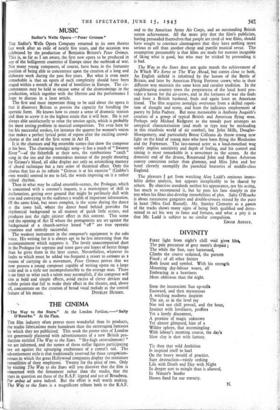THE CINEMA
THE film industry often proves more wonderful than its products, the studio fabrications more humdrum than the extravagant fantasies by which they are publicised. This week the poster sites of London are generously plastered with advertisements of a new British pro- duction entitled The Way to the Stars. "Sky-high entertainment!" we are informed, and the names of those stellar figures participating are set against the upsurging exuberance of a comet's tail. The advertisement style is that traditionally reserved for those symposium- revues in which the great Hollywood companies display the miniature versatilities of their employees. Twenty for the price of two. Only by visiting The Way to the Stars will you discover that the film is concerned with the firmament rather than -the studio, that the stars in question are those of the R.A.F. legend and not of Broadway. Per crrdua ad astra indeed. But the effort is well worth making. The Way to the Stars is a magnificent tribute both to the R.A.F.
and to the American Army Air Corps, and an outstanding British screen achievement. All the more pity that the film's publicists, having persuaded themselves that people are tired of war films, should have sought to convince cinemagoers that they have nothing more serious to sell than another cheap and puerile musical revue. The assumption presumably is that films are made for morons incapable of liking what is good, but who may be tricked by pretending it is bad.
The Way to the Stars does not quite match the achievement of In Which We Serve or The Way Ahead, but comes close to both. An English airfield is inhabited by the heroes of the Battle of Britain, and later by American Flying Fortress crews,- who in their different way maintain the same keen and cavalier tradition. In the neighbouring country town the proprietress of the local hotel pro- vides a haven for the air-crews, and in the fortunes of war she finds and loses a British husband, finds and again loses an American friend. The film acquires nostalgic overtones from a skilled repeti- tion of thought and scene, and from the judicious employment of poetry by John Pudney. But most memorable is Anthony Asquith's creation of a group of typical British and American flying men. Perhaps only Michael Redgrave as the moody poet attempts an untypical characterisation (and truth to type may be misleading in this ritualistic world of air combat), but John Mills, Douglas- Montgomery, and particularly Bonar Colleano do throw strong new light on the kind of young men who have been flying the Blenheims and the Fortresses. The last-named actor as a loud-mouthed wag subtly implies sensitivity and depth of feeling, and his control and timing is most remarkable in a newcomer to the screen. At the domestic end of the drama, Rosamund John and Renee Asherson convey conviction rather than glamour, and Miss John and her hotel cleverly exemplify the parochial braveries of middle-class England.
The pleasure I get from watching Alan Ladd's ominous immo- bility defies analysis, but appears inexplicably to be shared by others. By objective standards neither his appearance, nor his acting, has much to recommend it, but he puts his fans sharply to the test when his films also develop immobilities of plot. Salty O'Rourke is about racecourse gangsters and double-crosses erased by the pure in heart (Miss Gail Russell). Mr. Stanley Clements as a gamin of the tracks shows many signs of being both qualified and deter- mined to act his way to fame and fortune, and what a pity it i3 that Mr. Ladd is subject to no similar compulsion.
EDGAR ANSTEY.


























 Previous page
Previous page